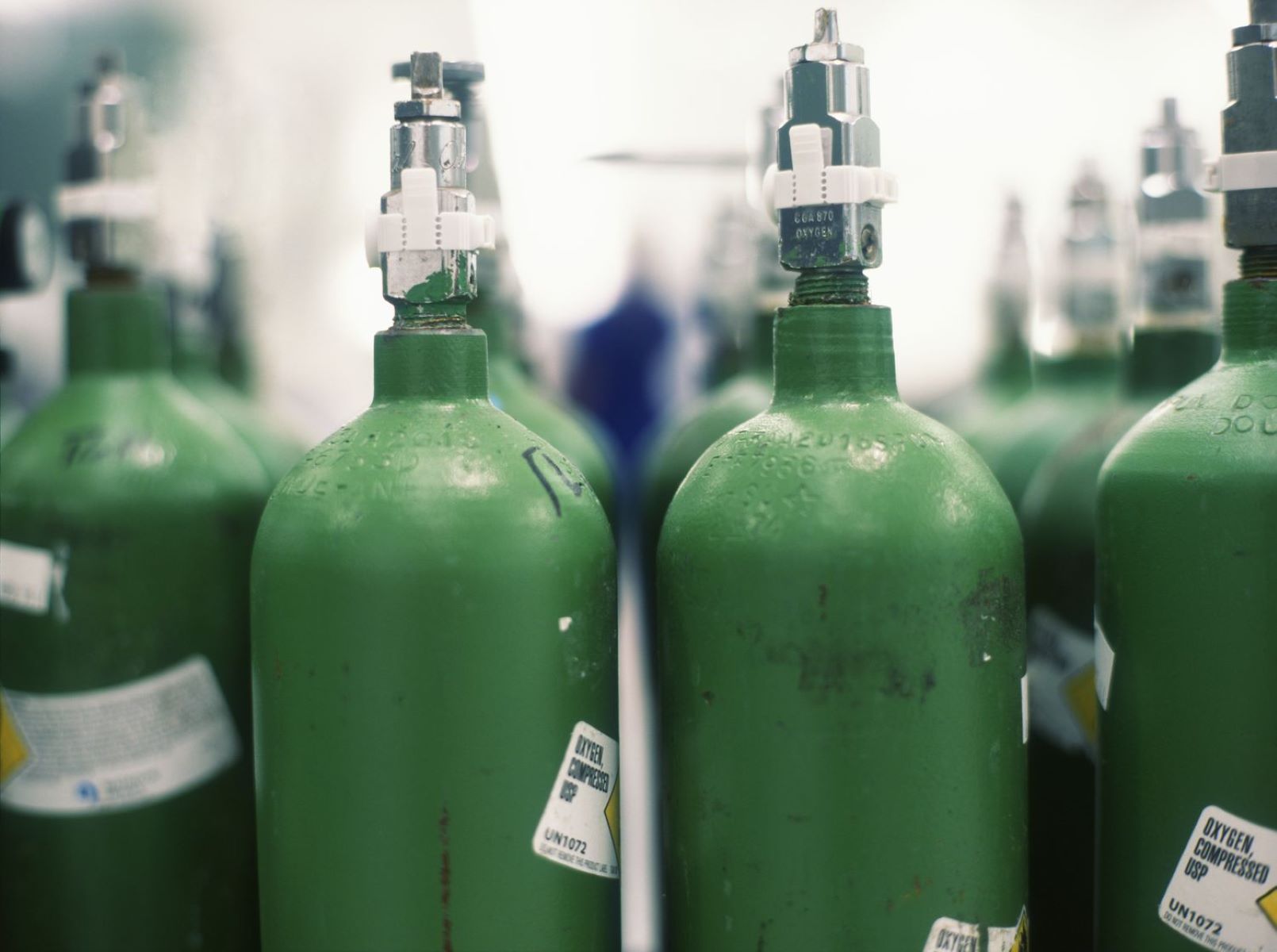Home>Science>Choosing The Right Gas Constant: Decoding The Units For Ideal Gas Law Problems


Science
Choosing The Right Gas Constant: Decoding The Units For Ideal Gas Law Problems
Published: January 25, 2024
Learn how to choose the right gas constant and decode the units for ideal gas law problems in this comprehensive guide. Perfect for science students.
(Many of the links in this article redirect to a specific reviewed product. Your purchase of these products through affiliate links helps to generate commission for Regretless.com, at no extra cost. Learn more)
Table of Contents
Introduction
The study of gases is an integral part of the field of science, with applications ranging from physics and chemistry to environmental science and engineering. One of the fundamental principles that govern the behavior of gases is the Ideal Gas Law, a powerful equation that relates the pressure, volume, temperature, and amount of gas in a system. Understanding and applying the Ideal Gas Law is crucial for solving a wide array of problems in various scientific disciplines.
At the heart of the Ideal Gas Law lies the gas constant, a crucial parameter that allows us to bridge the gap between macroscopic properties of gases and their microscopic behavior. The gas constant plays a pivotal role in the Ideal Gas Law equation, enabling scientists and engineers to make accurate predictions and calculations related to gas behavior.
In this comprehensive guide, we will delve into the intricacies of the Ideal Gas Law and explore the significance of the gas constant. We will unravel the different units associated with the gas constant and shed light on the process of selecting the appropriate gas constant for solving Ideal Gas Law problems. By the end of this journey, you will have a firm grasp of the essential concepts and tools needed to tackle ideal gas law problems with confidence and precision. Let's embark on this enlightening exploration of the gas constant and its role in the fascinating realm of gas behavior.
Read more: The Shocking Consequences Of Constant Neck Cracking In Teenagers: How To Prevent Future Problems!
Understanding the Ideal Gas Law
The Ideal Gas Law is a fundamental principle in the field of thermodynamics, providing a mathematical relationship between the pressure, volume, temperature, and amount of gas in a system. Expressed as PV = nRT, where P represents the pressure, V denotes the volume, n is the number of moles of gas, R is the gas constant, and T stands for the temperature in Kelvin, this equation encapsulates the behavior of ideal gases under varying conditions.
The Ideal Gas Law is based on several key assumptions about the behavior of gases. Firstly, it assumes that the gas particles are in constant, random motion and that they do not exert attractive or repulsive forces on each other. Additionally, the volume occupied by the gas particles is considered negligible compared to the volume of the container. Furthermore, the collisions between gas particles and the walls of the container are perfectly elastic, meaning that no energy is lost during these collisions.
By incorporating these assumptions, the Ideal Gas Law provides a simplified yet remarkably accurate model for understanding the behavior of gases in a wide range of practical scenarios. Whether it's calculating the pressure exerted by a certain volume of gas at a given temperature or predicting the volume occupied by a gas at a specific pressure and temperature, the Ideal Gas Law serves as an indispensable tool for scientists and engineers.
Moreover, the Ideal Gas Law forms the basis for numerous real-world applications, such as in the design of industrial processes, the development of climate models, and the understanding of atmospheric phenomena. Its versatility and applicability make it a cornerstone of thermodynamics and a vital component of the scientific toolkit.
In essence, the Ideal Gas Law encapsulates the intricate interplay between the fundamental properties of gases, providing a robust framework for analyzing and predicting their behavior. By comprehending the principles underpinning this law, scientists and researchers can unlock a deeper understanding of gas dynamics and leverage this knowledge to unravel a myriad of complex phenomena in the natural world.
The Role of Gas Constant in Ideal Gas Law
The gas constant, denoted by the symbol R, holds a pivotal role in the Ideal Gas Law, serving as a bridge that connects the macroscopic properties of gases to their microscopic behavior. This fundamental constant plays a crucial role in establishing the relationship between the pressure, volume, temperature, and amount of gas in a system, as defined by the equation PV = nRT.
At its essence, the gas constant embodies the combined effects of the individual gas particles' behavior within a system. It encapsulates the influence of temperature on the kinetic energy of gas particles, the impact of the number of gas particles present, and the relationship between the pressure and volume of the gas. In essence, the gas constant acts as a unifying factor, allowing scientists and engineers to make accurate predictions and calculations related to gas behavior across a diverse array of scenarios.
Moreover, the gas constant serves as a universal parameter, applying to all gases regardless of their specific chemical identity. This universality underscores the fundamental nature of the gas constant, highlighting its role as a unifying element that transcends the unique characteristics of individual gases. Whether it's hydrogen, oxygen, nitrogen, or any other gas, the gas constant provides a consistent link between the macroscopic properties of gases and the underlying behavior of their constituent particles.
In practical terms, the gas constant facilitates the conversion of units between pressure, volume, temperature, and amount of gas, enabling scientists and engineers to work seamlessly across different measurement systems. This capability is particularly valuable in diverse fields such as chemistry, physics, engineering, and environmental science, where the ability to manipulate and interpret gas-related data is essential for research, design, and problem-solving.
Furthermore, the gas constant plays a crucial role in elucidating the thermodynamic properties of gases, offering insights into the relationships between pressure, volume, and temperature under varying conditions. By leveraging the gas constant within the framework of the Ideal Gas Law, researchers can gain a deeper understanding of gas behavior and apply this knowledge to a wide spectrum of theoretical and practical endeavors.
In essence, the gas constant stands as a linchpin in the realm of gas dynamics, facilitating a deeper comprehension of gas behavior and empowering scientists and engineers to navigate the complexities of gas-related phenomena with precision and insight. Its significance as a unifying parameter and a key component of the Ideal Gas Law underscores its indispensable role in the study and application of gas principles.
Different Units for Gas Constant
The gas constant, denoted by the symbol R, is a fundamental parameter in the Ideal Gas Law equation, PV = nRT. As a universal constant that relates the pressure, volume, temperature, and amount of gas in a system, the gas constant is expressed in various units, each tailored to specific measurement systems and scientific contexts. Understanding the different units for the gas constant is essential for seamlessly integrating gas-related data across diverse applications and disciplines.
One of the most commonly encountered units for the gas constant is the liter-atmosphere per mole-kelvin (L·atm/mol·K). This unit is prevalent in contexts where the pressure is measured in atmospheres, the volume is expressed in liters, and the temperature is in Kelvin. It provides a practical framework for relating these parameters within the context of the Ideal Gas Law, offering a convenient means of interpreting and manipulating gas-related data.
In the realm of SI (International System of Units) measurements, the gas constant is often expressed in joules per mole-kelvin (J/mol·K). This unit aligns with the SI system's focus on energy-related measurements, providing a coherent representation of the gas constant in terms of energy per mole per degree of temperature. By employing this unit, scientists and engineers can seamlessly integrate gas-related calculations with other SI-based parameters, fostering consistency and compatibility across diverse scientific domains.
Another unit for the gas constant is the calorie per mole-kelvin (cal/mol·K), which finds application in specific scientific contexts where energy measurements are based on the calorie unit. This unit allows for the seamless integration of gas-related calculations with other calorimetry-based parameters, enabling researchers to navigate complex thermodynamic phenomena with precision and clarity.
Furthermore, the gas constant can be expressed in terms of the atmosphere-cubic meter per mole-kelvin (atm·m³/mol·K), particularly in engineering and environmental science applications where the volume is measured in cubic meters and the pressure is denoted in atmospheres. This unit provides a robust foundation for relating the gas constant to the pressure, volume, and temperature of gases within the framework of the Ideal Gas Law, catering to the specific measurement requirements of these disciplines.
In essence, the diverse units for the gas constant underscore its versatility and adaptability across various measurement systems and scientific domains. By embracing these different units, scientists and engineers can seamlessly integrate gas-related data, fostering a cohesive and comprehensive approach to understanding and manipulating the behavior of gases in diverse practical and theoretical contexts.
Choosing the Right Gas Constant for Ideal Gas Law Problems
When confronted with ideal gas law problems, the selection of the appropriate gas constant is paramount to ensuring accurate and precise calculations. The choice of gas constant hinges on the specific units used to express pressure, volume, temperature, and the amount of gas in a given problem. Understanding how to navigate the diverse units associated with the gas constant is essential for seamlessly integrating gas-related data and harnessing the full power of the Ideal Gas Law.
In scenarios where pressure is measured in atmospheres (atm) and volume is expressed in liters (L), the ideal choice for the gas constant is 0.0821 L·atm/mol·K. This unit aligns with the prevalent usage of atmospheres and liters in many laboratory and academic settings, providing a practical and intuitive framework for solving ideal gas law problems within these contexts.
For applications rooted in the International System of Units (SI), where pressure is typically quantified in pascals (Pa) and volume is denoted in cubic meters (m³), the gas constant is appropriately represented by 8.314 J/mol·K. This unit seamlessly integrates with the energy-based measurements of the SI system, offering a coherent and consistent representation of the gas constant in the realm of SI-based calculations.
In specific scientific contexts where energy measurements are based on the calorie unit, the gas constant is often expressed as 1.987 cal/mol·K. This unit allows for the seamless integration of gas-related calculations with other calorimetry-based parameters, providing researchers with a robust and tailored approach to solving ideal gas law problems within the domain of calorimetry and related fields.
Furthermore, in engineering and environmental science applications where the volume is measured in cubic meters and the pressure is denoted in atmospheres, the gas constant is effectively represented by 0.0821 atm·m³/mol·K. This unit offers a practical and versatile framework for relating the gas constant to the pressure, volume, and temperature of gases within the context of the Ideal Gas Law, catering to the specific measurement requirements of these disciplines.
By carefully selecting the appropriate gas constant that aligns with the units of pressure, volume, temperature, and amount of gas in a given problem, scientists and engineers can navigate ideal gas law problems with precision and confidence. This meticulous approach ensures that the calculations accurately reflect the behavior of gases under the specified conditions, laying the foundation for insightful analyses and informed decision-making across a spectrum of scientific and engineering endeavors.
Conclusion
In conclusion, the gas constant stands as a cornerstone of the Ideal Gas Law, serving as a unifying parameter that bridges the macroscopic properties of gases to their underlying microscopic behavior. Throughout our exploration, we have delved into the intricacies of the Ideal Gas Law, gaining a deeper understanding of its fundamental principles and far-reaching applications. From elucidating the role of the gas constant to unraveling the diverse units associated with this fundamental parameter, our journey has shed light on the pivotal role of the gas constant in the captivating realm of gas behavior.
By comprehending the essential concepts surrounding the gas constant and the Ideal Gas Law, scientists and engineers can wield a powerful toolkit for analyzing, predicting, and manipulating the behavior of gases across a myriad of practical and theoretical scenarios. Whether it's designing industrial processes, developing climate models, or unraveling atmospheric phenomena, the insights gained from our exploration empower us to navigate the complexities of gas dynamics with precision and insight.
Furthermore, the diverse units for the gas constant underscore its versatility and adaptability across various measurement systems and scientific domains. By embracing these different units, researchers can seamlessly integrate gas-related data, fostering a cohesive and comprehensive approach to understanding and manipulating the behavior of gases in diverse practical and theoretical contexts.
In essence, the gas constant encapsulates the combined effects of the individual gas particles' behavior within a system, offering a consistent link between the macroscopic properties of gases and the underlying behavior of their constituent particles. Its significance as a unifying parameter and a key component of the Ideal Gas Law underscores its indispensable role in the study and application of gas principles.
As we conclude our journey through the intriguing world of gas behavior and the pivotal role of the gas constant, we emerge equipped with a deeper appreciation for the elegant simplicity and profound implications of the Ideal Gas Law. This foundational principle, augmented by the unifying influence of the gas constant, empowers us to unravel the mysteries of gas behavior, paving the way for transformative discoveries and innovative advancements across the scientific landscape.












